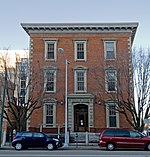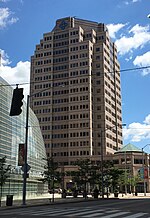Dayton Metro Library

Dayton Metro Library is a multi-branch library system serving 531,687 residents of the Dayton Metropolitan Area. It has 19 locations across the area (as well as two bookmobiles). Almost 5.8 million items were borrowed in 2018. The Dayton Metro Library ranks in the top ten best libraries in the United States serving a population of over 250,000 by HAPLR. The Dayton Metro Library system is considered a county system with branches in cities and towns throughout Montgomery County, Ohio, but does not have branches in Centerville, Germantown, Oakwood, Riverside or Washington Township. All are serviced by libraries of their own, save Riverside, various parts of which are geographically close to Dayton Metro Library locations, including Burkhardt, Electra C. Doren and Huber Heights.
Excerpt from the Wikipedia article Dayton Metro Library (License: CC BY-SA 3.0, Authors, Images).Dayton Metro Library
East 3rd Street, Dayton
Geographical coordinates (GPS) Address Phone number Nearby Places Show on map
Geographical coordinates (GPS)
| Latitude | Longitude |
|---|---|
| N 39.760556 ° | E -84.187857 ° |
Address
Dayton Metro Library (Dayton and Montgomery County Public Library)
East 3rd Street 215
45402 Dayton
Ohio, United States
Open on Google Maps






